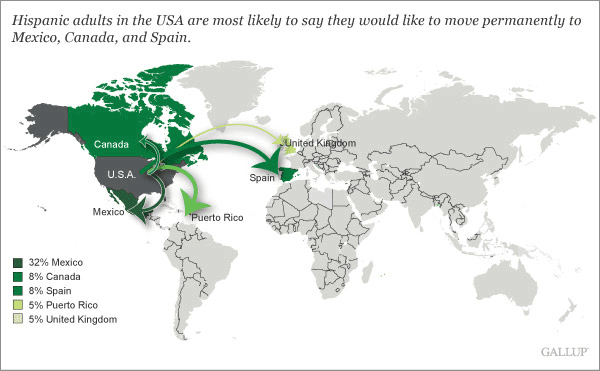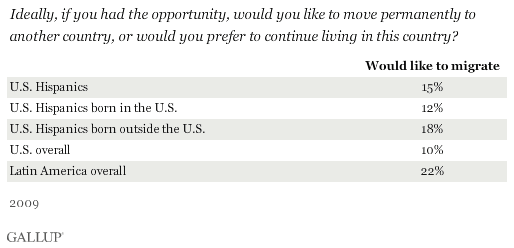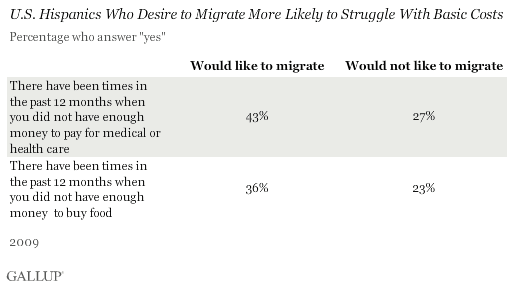WASHINGTON, D.C. -- A newly released Gallup study of U.S. Hispanics reveals that more than one in seven -- or an estimated 4 million adults -- would leave the U.S. permanently if they had the opportunity. A slim majority (52%) say they would like to move to a Latin American country, including nearly a third (32%) who would like to relocate to Mexico. A sizable minority -- or nearly 2 million adults -- would like to move to places such as Canada (8%), Spain (8%), the United Kingdom (5%), and other non-Latin American countries.

These results are based on interviews conducted in 2009 with adults of Hispanic origin or descent who reside permanently in the continental United States. Gallup has also studied adults' migration desires in 147 other countries since 2007 and finds similarities and differences among the desires of U.S. Hispanics and those of the U.S. general population and Latin Americans.
The 15% of U.S. Hispanics who say they would like to move to another country permanently if they could is higher than the 10% of Americans nationwide who say the same and lower than the 22% of would-be migrants in Latin America. The desire to migrate is slightly more pronounced among U.S. Hispanics born outside the U.S. (18%) and more in line with the level of desire measured in Latin America. The 12% of U.S.-born Hispanics who would like to move aligns more with U.S. adults overall.

Several of the top desired destinations among Hispanic potential migrants in the United States, such as Canada and Spain, are the same top desired destinations for potential migrants in Latin America. U.S. Hispanics, of course, already live in the No. 1 desired destination for potential migrants from Latin America.
Potential Migrants Less Integrated; Worse Off Economically
U.S. Hispanics who would like to migrate are caught between two worlds. Gallup's data show they are less integrated than those who don't want to migrate -- they're more likely to feel good only among other Hispanics, feel more discriminated against, and are less likely to speak English well. They not only experience more cultural tension, but also seem to be doing worse off economically, particularly with regard to their ability to afford healthcare for themselves and their families. Further, U.S. Hispanics who would like to migrate are more likely to say they have sent remittances back home in the past 12 months and are less optimistic about the future possibility of increasing or maintaining the amount of these remittances.

And, although they live in the land of the free, U.S. Hispanics who would like to migrate are less likely to feel that they are enjoying this benefit. While 91% of those who do not wish to migrate are satisfied with the freedom they have to choose what they do with their lives, 77% of would-be migrants say the same.
Bottom Line
Gallup's survey suggests that U.S. Hispanics who would like to migrate are more likely to be struggling, foreign-born residents who are ready to give up the American dream and move home or try again somewhere else. These findings have implications not only on the national debate about immigration reform in the United States, but also on the immigration policies and economies of other countries to which these potential migrants would like to move.
Timothy B. Gravelle provided additional analysis and technical assistance to this report.
For complete data sets or custom research from the more than 150 countries Gallup continually surveys, please contact SocialandEconomicAnalysis@gallup.com or call 202.715.3030.
U.S. Hispanic Study Survey Methods
The results of this study are based on a telephone sample of 1,000 adults, aged 15 and older, who are of Hispanic origin or descent and reside permanently in the continental U.S. For results based on the total sample 1,000 cases, one can say with 95% confidence that the maximum design effect-adjusted margin of sampling error is ±4.2 percentage points. In addition to sampling error, question wording and practical difficulties in conducting surveys can introduce error or bias into the findings of public opinion polls.
Sampling Frame: The sampling frame for this study comprised 18,321 individuals of self-identified Hispanic origin who Gallup had previously interviewed as part of a different survey and agreed to be re-contacted for additional surveys. The original survey was a Gallup Daily tracking poll of 1,000 individuals conducted among the general U.S. adult population by means of a random-digit-dial sampling supplemented by a list of cell phone numbers. For the purpose of the U.S. Hispanic study, in the case of landline (household) phone numbers, new respondents were randomly selected by means of the most recent birthday method.
Sampling Method: Random stratified. Given the high predominance of individuals of Mexican origin or descent in the U.S. Hispanic population and Gallup's need to maximize the sample sizes for other nationality groups for analytical purposes, a disproportionate sample design was used to oversample states with high concentrations of U.S. Hispanics whose origin or descent is other than Mexican. Such disproportions have been corrected by means of a post-stratification weighting procedure. The following are the sampling quotas collected by state:
- California: n=175
- Texas: n=100
- New York: n=150
- Florida: n=150
- All other states: n=425
Interviewing Language: Gallup used a team of bilingual interviewers to conduct this study. Interviewers started all interviews in Spanish and then switched to English when necessary or when the respondent preferred.
Sample Coverage: Aside from the potential bias derived from the previously described procedure for constructing the sampling frame, the sample represents U.S. Hispanics adults living in the entire continental U.S., including locations (phone exchanges) with less than 1% of U.S. Hispanic density, as well as cell phone-only individuals.
